Geo-Referenced Databases and SWOT Analysis for Assessing Flood Protection Structures, Measures, and Works at a River Basin Scale
Abstract
:1. Introduction
2. Materials and Methods
2.1. Case Study Area
2.2. Geographic Information System and Integrated Data
2.3. SWOT Analysis and Questionnaires’ Identity
3. Results
3.1. Flood Protection Projects and Flood Occurrences
3.2. Flood Protection Technical Works
3.3. SWOT Analysis Outputs
3.3.1. Urban Environment
3.3.2. Riparian Environment
3.3.3. Agricultural Environment
3.3.4. Natural Environment
4. Discussion
5. Conclusions
Author Contributions
Funding
Data Availability Statement
Conflicts of Interest
Appendix A
| Environments | Strengths | Score | Weaknesses | Score |
|---|---|---|---|---|
| Urban | S1—Flood protection infrastructure projects | 3 | W1—Aging of protection infrastructure | 4 |
| S2—Experience in flood management | 2 | W2—Change in flood flow due to human activity | 4 | |
| S3—Maintenance of flood protection projects | 2 | W3—Change in watercourse natural routing | 3 | |
| S4—Crisis management services | 2 | W4—Change of urban land uses | 4 | |
| S5—Existing stormwater networks’ enhancement | 3 | W5—Local scale interventions | 3 | |
| S6—Development of early warning systems | 1 | W6—Wetland vegetation change | 1 | |
| S7—Water resource management projects | 3 | W7—Non-water-related structures affecting water | 4 | |
| S8—Public information actions | 2 | W8—Expansion of settlement areas | 2 | |
| S9—Specified uses and activities | 3 | W9—Corruption phenomena | 1 | |
| S10—Mobile flood protection systems | 3.5 | W10—Periodic floods | 4 | |
| W11—Flash floods | 4 | |||
| W12—Environmental hazards affecting water | 3 | |||
| W13—Aging of sewage systems | 3 | |||
| W14—Lack of permanent/ temporal measures | 4 | |||
| W15—Lack of monitoring systems | 4 | |||
| W16—Inability of administration to manage floods | 4 | |||
| Riverine | S1—Flood protection projects/measures | 2.5 | W1—Change in river discharge volumes | 3.5 |
| S2—Water saving projects/dams | 3 | W2—Mankind soil morphology changes | 2.5 | |
| S3—Hydronomy: water management projects | 2 | W3—Changes in natural watercourse routing | 4 | |
| S4—Water quality improvement projects | 1.5 | W4—Changes in land uses | 3 | |
| S5—Wetland-based flood protection projects | 2 | W5—Landscape interventions | 1 | |
| S6—Modification of water sources | 2 | W6—Wetland vegetation changes | 4 | |
| S7—Recreational activities projects in water bodies | 2 | W7—Non-water-related structures affecting water | 4.5 | |
| S8—Water-related environmental protection projects | 3.5 | W8—Settlements expansion | 3 | |
| S9—Establishment of water use and protection zones | 3 | W9—Erosion phenomena | 3 | |
| S10—Mobile flood protection systems | 3.5 | W10—Periodic floods | 4 | |
| W11—Flash floods | 4.5 | |||
| W12—Restructuring of agricultural lands | 1 | |||
| W13—Environmental hazards affecting water | 2 | |||
| W14—Aged protection structures | 4 | |||
| W15—Absence of new flood protection constructions | 4.5 | |||
| W16—Lack of monitoring systems | 3.5 | |||
| W17—Understaffing of administration | 3.5 | |||
| Agricultural | S1—Flood protection infrastructure projects | 1 | W1—Flood discharges due to lack of projects | 4.5 |
| S2—Water saving projects/dams | 2.5 | W2—Change in soil morphology due to crops | 2 | |
| S3—Hydronomy: water management projects | 3 | W3—Change in natural watercourse routing | 3 | |
| S4—Water supply and irrigation projects | 2.5 | W4—Change in land uses | 4.5 | |
| S5—Water quality improvement projects | 2.5 | W5—Individual projects not falling within the regional planning | 2.2 | |
| S6—Wetland management projects | 2 | W6—Change in wetland vegetation | 2 | |
| S7—Water resource management projects | 2 | W7—Non-water-related structures affecting water | 4.5 | |
| S8—Recreational activities projects in water bodies | 2 | W8—Increased water demands in irrigation period | 3.3 | |
| S9—Water-related environmental protection projects | 3.5 | W9—Increase in arable land | 2.5 | |
| S10—Establishment of water use and protection zones | 3 | W10—Erosion phenomena | 2 | |
| S11—Specified land uses | 1 | W11—Periodic floods | 4 | |
| S12—Mobile flood protection systems | 1 | W12—Flash floods | 4 | |
| W13—Restructuring of agricultural lands | 0.9 | |||
| W14—Environmental hazards affecting water | 2.5 | |||
| W15—Absence of new flood protection constructions | 3.5 | |||
| W16—Absence of non-structural protection measures | 4 | |||
| W17—Lack of monitoring systems | 4 | |||
| W18—Understaffing of administration | 4 | |||
| Natural | S1—Administrative flood protection actions | 2 | W1—Change in river discharge volumes | 4 |
| S2—Water saving projects/dams | 2 | W2—Mankind soil morphology changes | 2 | |
| S3—Hydronomy: water management projects | 1.5 | W3—Changes in natural watercourse routing | 3 | |
| S4—Water supply and irrigation projects | 2 | W4—Changes in land uses | 2 | |
| S5—Water quality improvement projects | 2 | W5—Repetitive flood protection works at the local scale | 3 | |
| S6—Wetland systems development projects | 3.5 | W6—Wetland vegetation changes | 3 | |
| S7—Cross-border cooperation for environmental protection | 2.5 | W7—Technical works without environmental criteria | 4.5 | |
| S8—Hydropower projects | 2.5 | W8—Pressures on environmentally sensitive areas | 3.5 | |
| S9—Permanent flood protection/environmental protection projects | 3 | W9—Increased impacts due to increased phenomena intensity | 2 | |
| S10—Water purification projects | 2.5 | W10—Erosion phenomena | 2.5 | |
| S11—Temporary projects for water bodies’ environmental protection | 1 | W11—Restructuring of agricultural lands | 4.5 | |
| S12—Establishment of water use and protection zones | 2 | W12—Environmental hazards affecting water | 3 | |
| S13—Specified land uses | 2 | W13—Absence of new flood protection constructions | 3.5 | |
| S14—Mobile flood protection systems | 1 | W14—Absence of non-structural protection measures | 4 | |
| W15—Lack of monitoring systems | 2 | |||
| W16—Understaffing of administration | 2 |
| Environments | Opportunities | Score | Threats | Score |
|---|---|---|---|---|
| Urban | O1—Improvement of flood protection infrastructure | 4.5 | T1—Absence of a coordinated action plan | 2 |
| O2—Action plan for flood shielding | 4 | T2—Inadequate planning for flood protection | 4 | |
| O3—Assignment of responsibilities to administrative units | 3 | T3—Undefined responsibilities at administrative level | 4 | |
| O4— Development of flood protection systems | 4 | T4—Citizens’ inability to respond effectively in floods | 5 | |
| O5—Creation of flood monitoring systems | 2 | T5—Lack of flood monitoring systems | 2 | |
| O6—Development of civil protection mechanisms | 4 | T6—Limited flood protection project supervision during construction | 2 | |
| O7—Land use changes to reduce flood risk | 3 | T7—Understaffing of administration | 4 | |
| O8—Staff training in crisis management situations | 3 | T8—Non-expert staff in crisis management | 4 | |
| S9—Specified uses and activities | 4.5 | T9—Extreme phenomena frequency increase | 3 | |
| S10—Mobile flood protection systems | 4 | T10—Extreme phenomena intensity increase | 4 | |
| T11—Absence of public-awareness flood protocols | 5 | |||
| T12—Loss of property | 3 | |||
| T13—Loss of life/injuries | 3 | |||
| Riverine | O1—Improvement in flood protection infrastructure | 3 | T1—Absence of a coordinated action plan | 4 |
| O2—Action plan for flood shielding | 4 | T2—Inadequate planning for flood protection | 3 | |
| O3—Assignment of responsibilities to administrative units | 3.5 | T3—Undefined responsibilities at administrative level | 4 | |
| O4—Cross-border cooperation for flood protection | 2 | T4—Insufficient management of water bodies | 4.5 | |
| O5—Reconstruction of important flood protection structures | 4.5 | T5—Inability of large technical structures to regulate max flows | 5 | |
| O6—Creation of flood monitoring systems | 2 | T6—Absence of water status monitoring system | 2.5 | |
| O7—Development of civil protection mechanisms | 3 | T7—Limited flood protection project supervision during construction | 4 | |
| O8—Assessment of flood prone areas | 4.5 | T8—Understaffing of services/organizations | 3 | |
| O9—Staff training in crisis management situations | 2 | T9—Non-expert staff in crisis management | 2.5 | |
| O10—Prioritization of interventions | 4 | T10—Lack of public notification procedures in floods | 4.5 | |
| Agricultural | O1—Improvement in flood protection infrastructure | 2 | T1—Absence of a coordinated action plan | 3 |
| O2—Action plan for flood shielding | 3.5 | T2—Limited rational planning for flood protection | 4 | |
| O3—Informing the farmers | 1 | T3—Undefined responsibilities at administrative level | 3.5 | |
| O4—Cross-border cooperation for flood protection | 4 | T4—Limited technical protection equipment | 2.5 | |
| O6—Creation of flood monitoring systems | 2 | T5—Absence of a system for recording existing water status | 2 | |
| O7—Development of civil protection mechanisms | 3 | T6—Limited flood protection project supervision during construction | 4.5 | |
| O8—Change in land uses based on FRMP | 4.5 | T7—Degradation of regional agricultural economy | 3 | |
| O9—Restructuring of crop cultivation | 4.5 | T8—Change to more climate-resistant crops | 2 | |
| T9—Loss of income and products | 4.5 | |||
| T10—Expensive use of temporary measures | 2 | |||
| T11—Continuous degradation of rural areas due to floods | 3.5 | |||
| Natural | O1—Improvement in environmental protection works | 4 | T1—Absence of a coordinated action plan | 2.5 |
| O2—Action plan for flood shielding | 4.5 | T2—Limited rational planning for flood protection | 3 | |
| O3—Development of protection systems with environmental criteria | 5 | T3—Degradation of environmental services | 4 | |
| O4—Cross-border cooperation for flood protection | 4 | T4—Impacts on the anthropogenic environment | 2.5 | |
| O5—Creation of flood monitoring system | 3.5 | T5—Harm on the regional economy | 4 | |
| O6—Development of civil protection mechanisms | 4 | T6—Harm on the natural environment | 5 | |
| O7—Change in land uses based on FRMP | 3.5 | T7—Limited project supervision during construction in environmentally sensitive areas | 4 | |
| O8—Staff training in crisis management situations | 3 | T8—Non-expert staff in crisis management | 3 | |
| T9—Increased environmental costs due to climate crisis | 4.5 |
References
- Raadgever, G.T.; Booister, N.; Steenstra, M.K. The Relevance of Flood Risk Management and Governance. In Flood Risk Management Strategies and Governance; Springer International Publishing: Cham, Switzerland, 2018; pp. 85–92. [Google Scholar]
- Glasgow, H.B.; Burkholder, J.M.; Reed, R.E.; Lewitus, A.J.; Kleinman, J.E. Real-time remote monitoring of water quality: A review of current applications, and advancements in sensor, telemetry, and computing technologies. J. Exp. Mar. Biol. Ecol. 2004, 300, 409–448. [Google Scholar] [CrossRef]
- Skoulikaris, C.; Ganoulis, J.; Aureli, A. A critical review of the transboundary aquifers in South-Eastern Europe and new insights from the EU’s water framework directive implementation process. Water Int. 2021, 46, 1060–1086. [Google Scholar] [CrossRef]
- European Commission. Common implementation strategy for the water framework directive (2000/60/EC). In Guidance Document No. 7—Monitoring under the Water Framework Directive; Office for Official Publications of the Europe: Luxembourg, 2003. [Google Scholar]
- Kundzewicz, Z.W.; Pińskwar, I.; Brakenridge, G.R. Changes in River Flood Hazard in Europe: A Review. Hydrol. Res. 2018, 49, 294–302. [Google Scholar] [CrossRef]
- Nones, M. Implementation of the floods directive in selected EU member states. Water Environ. J. 2015, 29, 412–418. [Google Scholar] [CrossRef]
- Chimene, C.A.; Campos, J.N.B. The Design Flood under Two Approaches: Synthetic Storm Hyetograph and Observed Storm Hyetograph. J. Appl. Water Eng. Res. 2020, 8, 171–182. [Google Scholar] [CrossRef]
- Papaioannou, G.; Efstratiadis, A.; Vasiliades, L.; Loukas, A.; Papalexiou, S.M.; Koukouvinos, A.; Tsoukalas, I.; Kossieris, P. An Operational Method for Flood Directive Implementation in Ungauged Urban Areas. Hydrology 2018, 5, 24. [Google Scholar] [CrossRef]
- Reil, A.; Skoulikaris, C.; Alexandridis, T.K.; Roub, R. Evaluation of riverbed representation methods for one-dimensional flood hydraulics model. J. Flood Risk Manag. 2018, 11, 169–179. [Google Scholar] [CrossRef]
- Teng, J.; Jakeman, A.J.; Vaze, J.; Croke, B.F.W.; Dutta, D.; Kim, S. Flood Inundation Modelling: A Review of Methods, Recent Advances and Uncertainty Analysis. Environ. Model. Softw. 2017, 90, 201–216. [Google Scholar] [CrossRef]
- Alfieri, L.; Salamon, P.; Bianchi, A.; Neal, J.; Bates, P.; Feyen, L. Advances in pan-European flood hazard mapping. Hydrol. Process 2014, 28, 4067–4077. [Google Scholar] [CrossRef]
- Aronica, G.T.; Franza, F.; Bates, P.D.; Neal, J.C. Probabilistic evaluation of flood hazard in urban areas using monte carlo simulation. Hydrol. Process. 2012, 26, 3962–3972. [Google Scholar] [CrossRef]
- Hunter, N.M.; Bates, P.D.; Horritt, M.S.; Wilson, M.D. Simple spatially-distributed models for predicting flood inundation: A review. Geomorphology 2007, 90, 208–225. [Google Scholar] [CrossRef]
- Singh, P.; Gupta, A.; Singh, M. Hydrological inferences from watershed analysis for water resource management using remote sensing and GIS techniques. Egypt. J. Remote Sens. Space Sci. 2014, 17, 111–121. [Google Scholar] [CrossRef]
- Qi, H.; Qi, P.; Altinakar, M.S. GIS-Based Spatial Monte Carlo Analysis for Integrated Flood Management with Two Dimensional Flood Simulation. Water Resour. Manag. 2013, 27, 3631–3645. [Google Scholar] [CrossRef]
- Van Der Knijff, J.M.; Younis, J.; De Roo, A.P.J. LISFLOOD: A GIS-based distributed model for river basin scale water balance and flood simulation. Int. J. Geogr. Inf. Sci. 2010, 24, 189–212. [Google Scholar] [CrossRef]
- McKinney, D.C.; Cai, X. Linking GIS and water resources management models: An object-oriented method. Environ. Model. Softw. 2002, 17, 413–425. [Google Scholar] [CrossRef]
- Tsihrintzis, V.A.; Hamid, R.; Fuentes, H.R. Use of geographic information systems (GIS) in water resources: A review. Water Resour. Manag. 1996, 10, 251–277. [Google Scholar] [CrossRef]
- Kourgialas, N.N.; Karatzas, G.P. Flood management and a GIS modelling method to assess flood-hazard areas—A case study. Hydrol. Sci. 2011, 56, 212–225. [Google Scholar] [CrossRef]
- Shaban, A.; Khawlie, M.; Abdallah, C. Use of remote sensing and GIS to determine recharge potential zones: The case of Occidental Lebanon. Hydrogeol. J. 2006, 14, 433–443. [Google Scholar] [CrossRef]
- Gemitzi, A.; Petalas, C.; Tsihrintzis, V.A.; Pisinaras, V. Assessment of Groundwater Vulnerability to Pollution: A Combination of GIS, Fuzzy Logic and Decision Making Techniques. Environ. Geol. 2006, 49, 653–673. [Google Scholar] [CrossRef]
- Samela, C.; Albano, R.; Sole, A.; Manfreda, S. A GIS Tool for Cost-Effective Delineation of Flood-Prone Areas. Comput. Environ. Urban Syst. 2018, 70, 43–52. [Google Scholar] [CrossRef]
- Ogato, G.S.; Bantider, A.; Abebe, K.; Geneletti, D. Geographic Information System (GIS)-Based Multicriteria Analysis of Flooding Hazard and Risk in Ambo Town and Its Watershed, West Shoa Zone, Oromia Regional State, Ethiopia. J. Hydrol. Reg. Stud. 2020, 27, 100659. [Google Scholar] [CrossRef]
- Tzanou, E.; Skoulikaris, C.; Chatzigiannis, A. Result-Based Management Tool for the Assessment of Existing Structural Flood Protection and Future Planning; Case Study in the Strymon River Basin, Greece. Environ. Sci. Proc. 2023, 25, 17. [Google Scholar] [CrossRef]
- Ghazinoory, S.; Abdi, M.; Azadegan-Mehr, M. SWOT methodology: A state-of-the-art review for the past, a framework for the future. J. Bus. Econ. Manag. 2011, 12, 24–48. [Google Scholar] [CrossRef]
- Lazaridou, D.; Michailidis, A.; Trigkas, M.; Stefanidis, P. Exploring irrigation water issue through quantitative SWOT Analysis: The case of Nestos river basin. In Economic and Financial Challenges for Eastern Europe; Sykianakis, N., Polychronidou, P., Karasavvoglou, A., Eds.; Springer: Cham, Switzerland, 2019; pp. 445–460. [Google Scholar]
- Nagara, G.; Lam, W.-H.; Lee, N.C.H.; Othman, F.; Shaaban, G. Comparative SWOT Analysis for Water Solutions in Asia and Africa. Water Resour. Manag. 2015, 29, 125–138. [Google Scholar] [CrossRef]
- Skias, S.; Pliakas, F.; Kallioras, A. Application of SWOT analysis for the management of transboundary river Evros (Bulgaria, Greece, Turkey). Int. J. Water 2013, 7, 104–121. [Google Scholar] [CrossRef]
- Mylopoulos, Y.; Kolokytha, E.; Kampragou, E.; Vagiona, D. A combined methodology for transboundary river basin management in Europe. Application in the Nestos-Mesta catchment area. Water Resour. Manag. 2008, 22, 1101–1112. [Google Scholar] [CrossRef]
- Supriyasilp, T.; Pongput, K.; Boonyanupong, S.; Suwanlertcharoen, T. Enhanced Water Management for Muang Fai Irrigation Systems through Remote Sensing and SWOT Analysis. Water Resour. Manag. 2021, 35, 263–277. [Google Scholar] [CrossRef]
- Goli, I.; Azadi, H.; Nooripoor, M.; Baig, M.; Viira, A.; Ajtai, I.; Ozgueven, A. Evaluating the Productivity of Paddy Water Resources through SWOT Analysis: The Case of Northern Iran. Water 2021, 13, 2964. [Google Scholar] [CrossRef]
- Sibtain, M.; Li, X.; Bashir, H.; Azam, M.I. Hydropower exploitation for Pakistan’s sustainable development: A SWOT analysis considering current situation, challenges, and prospects. Energy Strategy Rev. 2021, 38, 100728. [Google Scholar] [CrossRef]
- Skoulikaris, C. Transboundary Cooperation Through Water Related EU Directives’ Implementation Process. The Case of Shared Waters Between Bulgaria and Greece. Water Resour Manag. 2021, 35, 4977–4993. [Google Scholar] [CrossRef]
- Ovakoglou, G.; Alexandridis, T.K.; Crisman, T.L.; Skoulikaris, C.; Vergos, G.S. Use of MODIS satellite images for detailed lake morphometry: Application to basins with large water level fluctuations. Int. J. Appl. Earth Obs. Geoinf. 2016, 51, 37–46. [Google Scholar] [CrossRef]
- Alexandridis, T.K.; Lazaridou, E.; Tsirika, A.; Zalidis, G.C. Using Earth Observation to Update a Natura 2000 Habitat Map for a Wetland in Greece. J. Environ. Manag. 2009, 90, 2243–2251. [Google Scholar] [CrossRef]
- Hellenic Ministry of Environment and Energy. Flood Risk Management Plan of River Basin District of Eastern Macedonia, Greece. 2018. Available online: https://cdr.eionet.europa.eu/gr/eu/frmp/el11/doc/envw9bc5a/FRMP_EL11.pdf (accessed on 29 July 2024). (In Greek).
- Capolongo, D.; Refice, A.; Bocchiola, D.; D’Addabbo, A.; Vouvalidis, K.; Soncini, A.; Zingaro, M.; Bovenga, F.; Stamatopoulos, L. Coupling Multitemporal Remote Sensing with Geomorphology and Hydrological Modeling for Post Flood Recovery in the Strymonas Dammed River Basin (Greece). Sci. Total Environ. 2019, 651, 1958–1968. [Google Scholar] [CrossRef] [PubMed]
- Rossetto, R.; De Filippis, G.; Borsi, I.; Foglia, L.; Cannata, M.; Criollo, R.; Vázquez-Suñé, E. Integrating free and open source tools and distributed modelling codes in GIS environment for data-based groundwater management. Environ. Model. Softw. 2018, 107, 210–230. [Google Scholar] [CrossRef]
- Bhatt, G.; Kumar, M.; Duffy, C.J. A tightly coupled GIS and distributed hydrologic modeling framework. Environ. Model. Softw. 2014, 62, 70–84. [Google Scholar] [CrossRef]
- Directive 2012/18/EU of the European Parliament and of the Council of 4 July 2012 on the Control of Major-Accident Hazards Involving Dangerous Substances. July 2012. Available online: https://eur-lex.europa.eu/legal-content/EN/TXT/?uri=celex%3A32012L0018 (accessed on 24 February 2024).
- Katirtzidou, M.; Skoulikaris, C.; Makris, C.; Baltikas, V.; Latinopoulos, D.; Krestenitis, Y. Modeling Stakeholders’ Perceptions in Participatory Multi-risk Assessment on a Deltaic Environment Under Climate Change Conditions. Environ. Model. Assess. 2023, 28, 367–388. [Google Scholar] [CrossRef]
- Beierle, T.C.; Konisky, D.M. Values, conflict, and trust in participatory environmental planning. J. Policy Anal. Manag. 2000, 19, 587–602. [Google Scholar] [CrossRef]
- Psilovikos, A.; Margoni, S. An empirical model of sediment deposition processes in Lake Kerkini, Central Macedonia Greece. Environ. Monit. Assess. 2010, 164, 573–592. [Google Scholar] [CrossRef] [PubMed]
- Hellenic Ministry of Environment and Energy. 1st Revision of the Preliminary Flood Risk Assessment and Areas of Potential Significant Flood Risk. 2019. Available online: https://cdr.eionet.europa.eu/gr/eu/floods2019/pfra_2019/documents/national/envx7ufyg/PFRA_REVISION_REPORT_vf.pdf (accessed on 27 May 2024). (In Greek).
- Skoulikaris, C. Toponyms: A neglected asset within the water framework and flood directives implementation process; the case study of Greece. Acta Geophys. 2023, 71, 1801–1815. [Google Scholar] [CrossRef]
- Theofanous, N.; Myronidis, D. A streamflow hydrograph analysis and simulation for a study case watershed. Int. J. Sustain. Agric. Manag. Inform. 2020, 6, 94–105. [Google Scholar] [CrossRef]
- Bhuiyan, H.A.K.M.; McNairn, H.; Powers, J.; Merzouki, A. Application of HEC-HMS in a Cold Region Watershed and Use of RADARSAT-2 Soil Moisture in Initializing the Model. Hydrology 2017, 4, 9. [Google Scholar] [CrossRef]
- Kulkarni, A.; Mohanty, J.; Eldho, T.; Rao, E.; Mohan, B. A web GIS based integrated flood assessment modeling tool for coastal urban watersheds. Comput. Geosci. 2014, 64, 7–14. [Google Scholar] [CrossRef]
- Ghorbani, M.K.; Hamidifar, H.; Skoulikaris, C.; Michael, N. Concept-Based Integration of Project Management and Strategic Management of Rubber Dam Projects Using the SWOT–AHP Method. Sustainability 2022, 14, 2541. [Google Scholar] [CrossRef]
- Long, Y.; Li, Y.; Lei, X.; Hou, Y.; Guo, S.; Sun, J. A Study on Comprehensive Evaluation Methods for Coordinated Development of Water Diversion Projects Based on Advanced SWOT Analysis and Coupling Coordination Model. Sustainability 2021, 13, 13600. [Google Scholar] [CrossRef]
- Srinivas, R.; Singh, A.P.; Dhadse, K.; Garg, C.; Deshmukh, A. Sustainable management of a river basin by integrating an improved fuzzy based hybridized SWOT model and geo-statistical weighted thematic overlay analysis. J. Hydrol. 2018, 563, 92–105. [Google Scholar] [CrossRef]
- Miles, V.; Esau, I.; Pettersson, L. Using web GIS to promote stakeholder understanding of scientific results in sustainable urban development: A case study in Bergen, Norway. Sustain. Dev. 2024, 32, 2517–2529. [Google Scholar] [CrossRef]
- Kaffas, K.; Pisaturo, G.R.; Premstaller, G.; Hrissanthou, V.; Penna, D.; Righetti, M. Event-based soil erosion and sediment yield modelling for calculating long-term reservoir sedimentation in the Alps. Hydrol. Sci. J. 2024, 69, 321–336. [Google Scholar] [CrossRef]
- Thaler, T.; Nordbeck, R.; Seher, W. Cooperation in flood risk management: Understanding the role of strategic planning in two Austrian policy instruments. J. Environ. Sci. Policy 2020, 114, 170–177. [Google Scholar] [CrossRef]
- Cea, L.; Costabile, P. Flood Risk in Urban Areas: Modelling, Management and Adaptation to Climate Change. A Review. Hydrology 2022, 9, 50. [Google Scholar] [CrossRef]
- Tolika, K.; Skoulikaris, C. Atmospheric circulation types and floods’ occurrence; A thorough analysis over Greece. Sci. Total Environ. 2023, 865, 161217. [Google Scholar] [CrossRef]
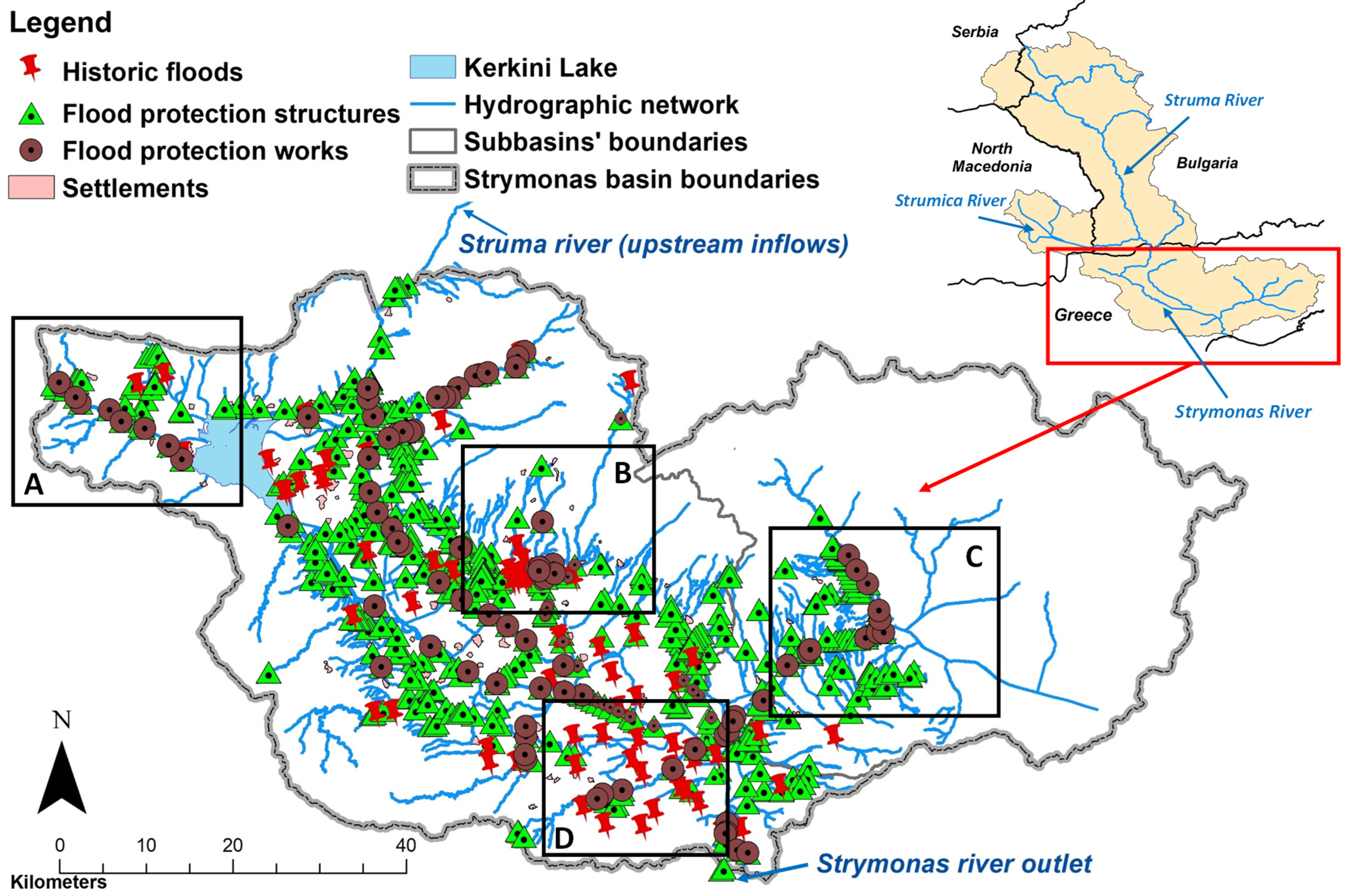
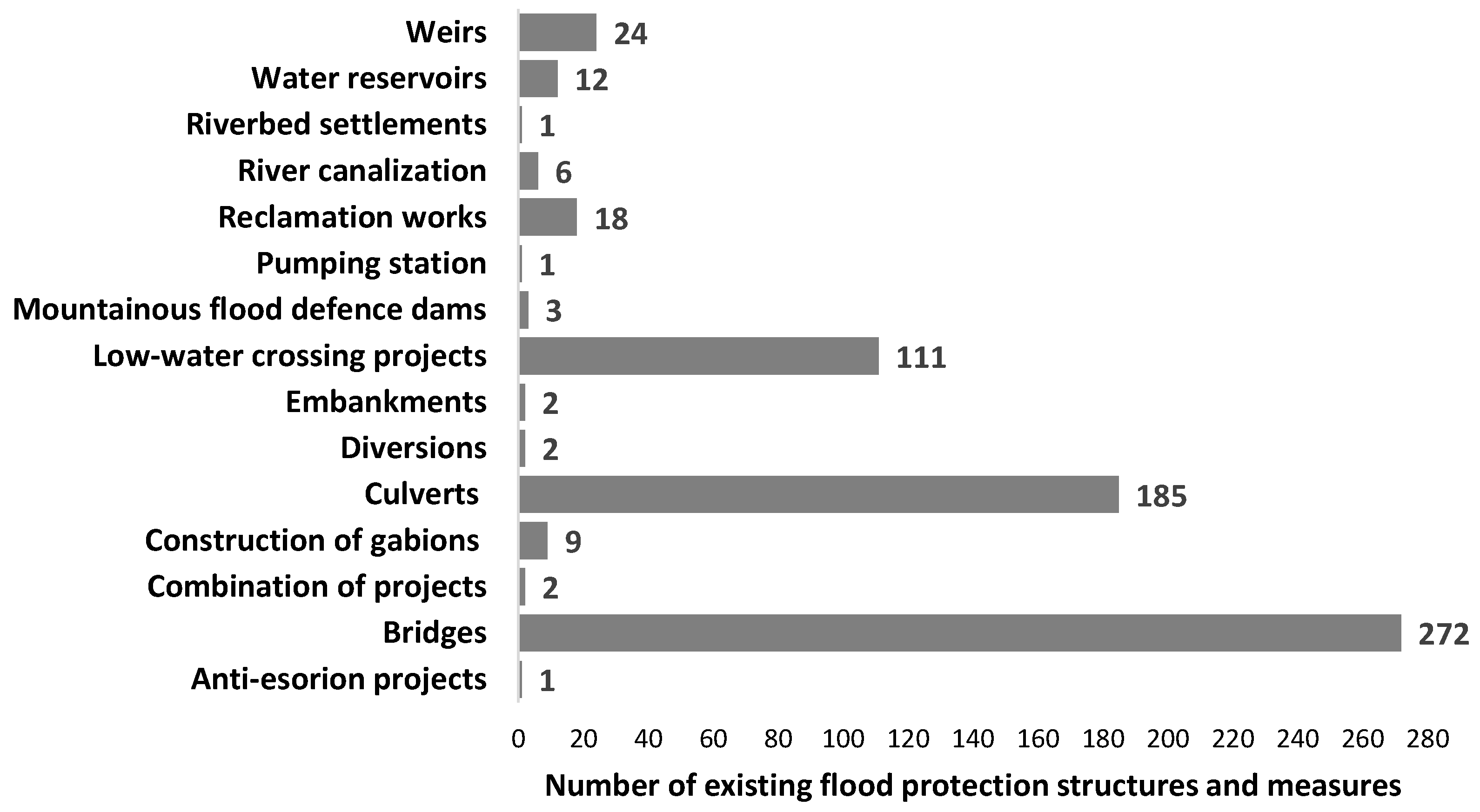

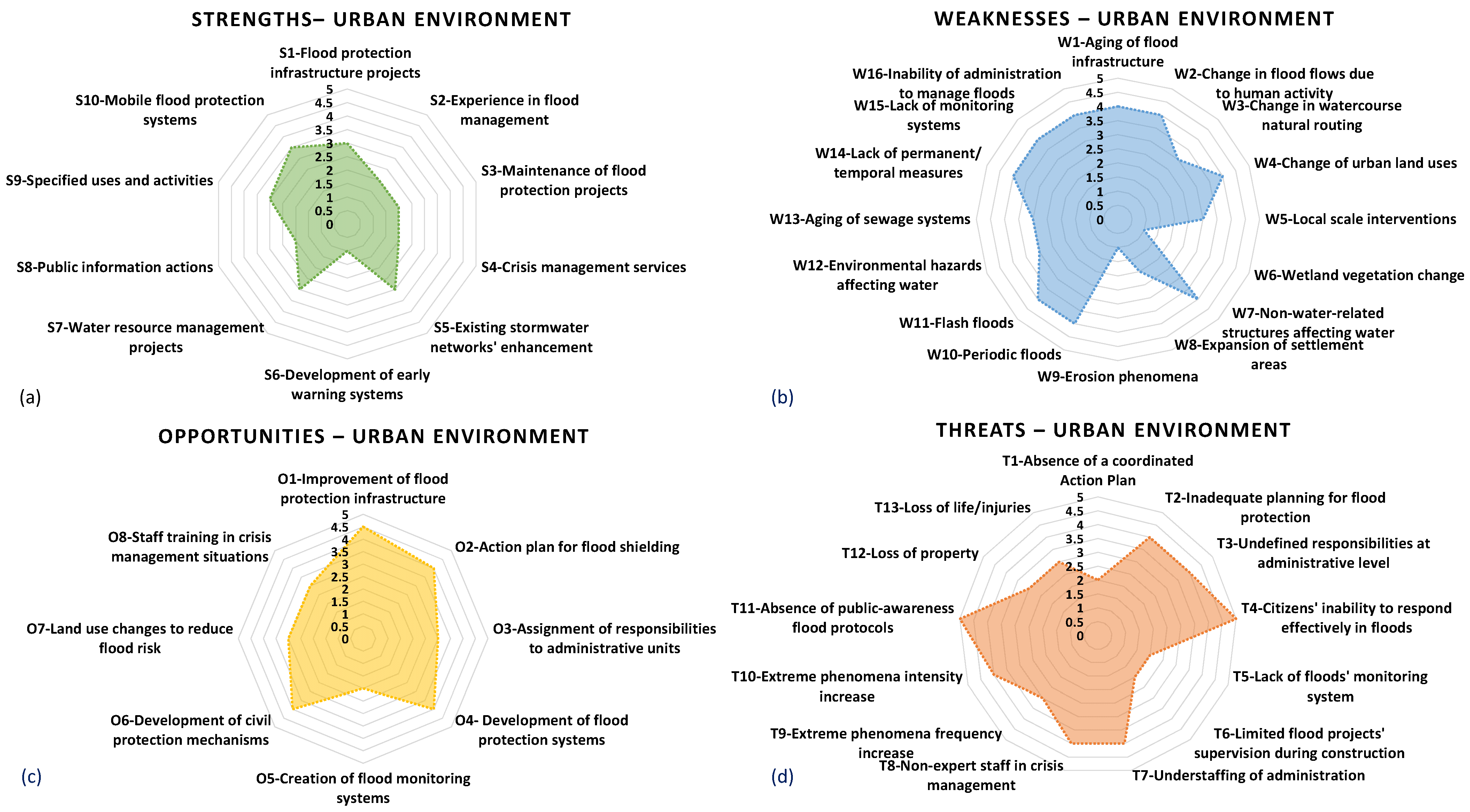
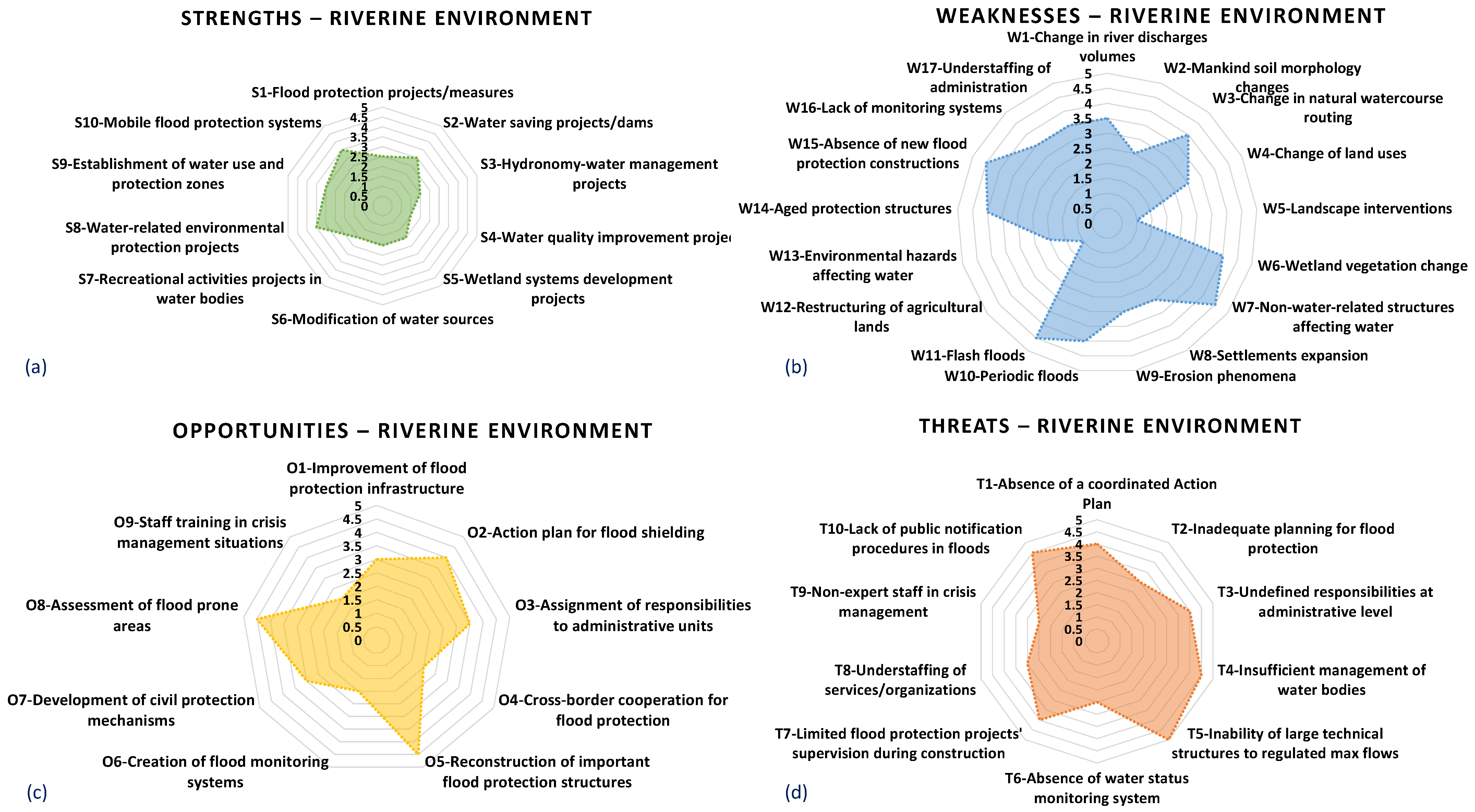

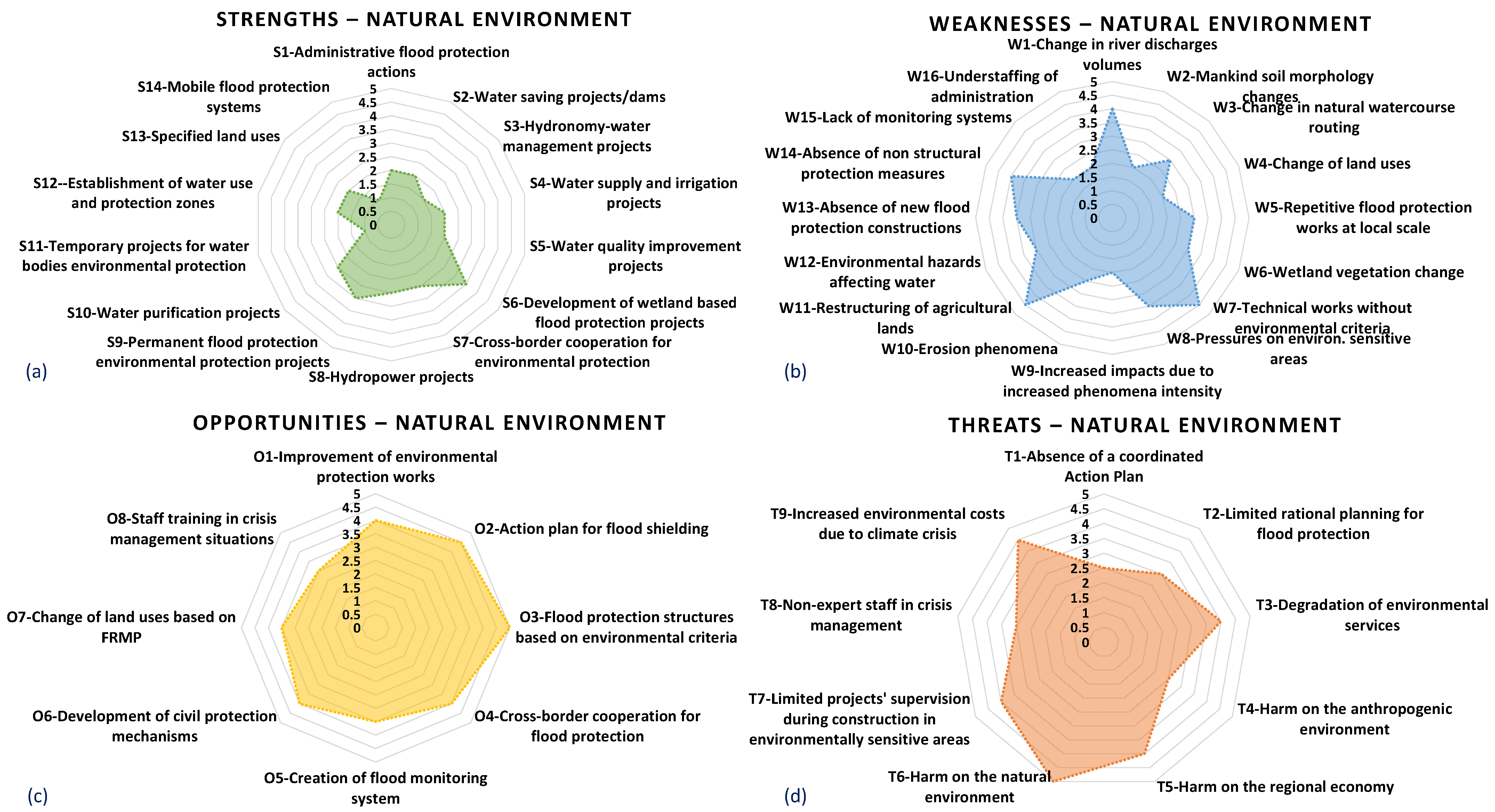
| River Basin | Riparian Countries | Area (km2) | Country’s Share (%) | Mean Elevation (m) | River Length (km) | Annual Rainfall (mm) | Annual Discharges (×106 m3) |
|---|---|---|---|---|---|---|---|
| Struma/Strymonas | Bulgaria | 8545 | 48.9 | 900 | 290 | 900 | 2160 |
| Greece | 7282 | 41.7 | 430 | 110 | 675 | 1514 | |
| North Macedonia | 1648 | 9.4 | 863 | 81 | 688 | 50.1 |
| No | Dataset Name | Description | Source |
|---|---|---|---|
| 1 | Hydrological characteristics | Contains information related to the basin’s boundaries, the surface water bodies network, the sub-catchments, and the monitoring stations. | Ministry Portal of the WFD implementation process in Greece 1 |
| 2 | Land uses and environmentally protected areas | CORINE land uses and Natura 2000 Special Areas of Conservation (SACs) and Special Protection Areas (SPAs). | CORINE Land Cover inventory 2; Natura 2000 Network and protected areas 3 |
| 3 | Settlements, critical infrastructures and SEVESO | Contains the basin’s settlements, infrastructures of particular importance (e.g., hospitals, schools, administration buildings, roads, etc.), and industries subject to the SEVESO Directive of the EU [40]. | Open geospatial data and services for Greece 4 |
| 4 | Flood hazard maps and historical floods | Includes flood boundaries for different return periods and historical flood events until the year 2018. | Ministry Portal of the FD implementation in Greece 5 |
| 5 | Flood protection structures and measures | Shapefiles indicating the location and the descriptive characteristics of the flood protection structures (e.g., dams, bridges, levees, berms, etc.) and measures (e.g., low water crossing projects) | Survey in public administration’s records |
| 6 | Flood protection works | Location and descriptive characteristics of flood protection works (e.g., work type, cost, implementation date) | Survey in public administration’s records |
| Urban Env. | Riparian Env. | Agricultural Env. | Natural Env. | Total | |
|---|---|---|---|---|---|
| Strengths | 10 | 10 | 12 | 14 | 46 |
| Weaknesses | 16 | 17 | 18 | 15 | 66 |
| Opportunities | 13 | 10 | 11 | 09 | 43 |
| Threats | 8 | 10 | 9 | 08 | 35 |
| Time Period | Historic Floods | Significant Floods | Significant over Total Floods |
|---|---|---|---|
| 1950–2011 | 69 | 10 | 14% |
| 2012–2018 | 32 | 19 | 59% |
| Total | 101 | 29 | 29% |
Disclaimer/Publisher’s Note: The statements, opinions and data contained in all publications are solely those of the individual author(s) and contributor(s) and not of MDPI and/or the editor(s). MDPI and/or the editor(s) disclaim responsibility for any injury to people or property resulting from any ideas, methods, instructions or products referred to in the content. |
© 2024 by the authors. Licensee MDPI, Basel, Switzerland. This article is an open access article distributed under the terms and conditions of the Creative Commons Attribution (CC BY) license (https://creativecommons.org/licenses/by/4.0/).
Share and Cite
Tzanou, E.; Skoulikaris, C. Geo-Referenced Databases and SWOT Analysis for Assessing Flood Protection Structures, Measures, and Works at a River Basin Scale. Hydrology 2024, 11, 136. https://doi.org/10.3390/hydrology11090136
Tzanou E, Skoulikaris C. Geo-Referenced Databases and SWOT Analysis for Assessing Flood Protection Structures, Measures, and Works at a River Basin Scale. Hydrology. 2024; 11(9):136. https://doi.org/10.3390/hydrology11090136
Chicago/Turabian StyleTzanou, Eleni, and Charalampos Skoulikaris. 2024. "Geo-Referenced Databases and SWOT Analysis for Assessing Flood Protection Structures, Measures, and Works at a River Basin Scale" Hydrology 11, no. 9: 136. https://doi.org/10.3390/hydrology11090136







